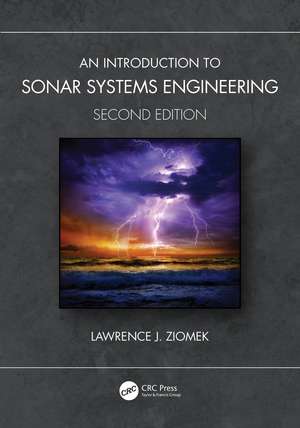An Introduction to Sonar Systems Engineering
Autor Lawrence J. Ziomeken Limba Engleză Paperback – 29 iul 2024
Second Edition
Important topics that are fundamental to the understanding of modern-day sonar systems engineering are featured. Linear, planar, and volume array theory, including near-field and far-field beam patterns, beam steering, and array focusing, are covered. Real-world arrays such as the twin-line planar array and a linear array of triplets, which are solutions to the port/starboard (left/right) ambiguity problem associated with linear towed arrays, are examined in detail.
Detailed explanations of the fundamentals of side-looking (side-scan) and synthetic-aperture sonars are presented. Bistatic scattering with moving platforms is explored with derivations of exact solutions for the time delay, time-compression/time-expansion factor, and Doppler shift at a receiver for both the scattered and direct acoustic paths. Time-domain and frequency-domain descriptions, and the design of CW, LFM, and Doppler-invariant HFM pulses, are explained. Target detection in the presence of reverberation and noise is examined. Time-domain and frequency-domain descriptions of MFSK, MQAM, and OFDM underwater acoustic communication signals are also discussed.
Although the book is mathematically rigorous, it is written in a tutorial style. Many useful, practical design and analysis equations for both passive and active sonar systems are derived from first principles. No major steps in the derivation of important results are skipped – all assumptions and approximations are clearly stated. Particular attention is paid to the correct units for functions and parameters. Many figures, tables, examples, and practical homework problems at the end of each chapter are included to aid in the understanding of the material covered.
New to the Second Edition
- Chapter 15 Synthetic-Aperture Sonar
- Chapter 13, Section 13.3, The Rectangular-Envelope HFM Pulse
- Chapter 10, Section 10.7, Moving Platforms, was rewritten, which allowed for the elimination of Appendix 10C from the first edition
- New explanations/discussions were added to Subsections 1.2.1 and 1.3.1 in Chapter 1
- Appendix 1A was rewritten and the new Table 1A-1 was added to Chapter 1
- A solutions manual is available for adopting professors
Preț: 473.68 lei
Nou
Puncte Express: 711
Preț estimativ în valută:
90.69€ • 93.03$ • 76.36£
90.69€ • 93.03$ • 76.36£
Carte tipărită la comandă
Livrare economică 26 februarie-12 martie
Preluare comenzi: 021 569.72.76
Specificații
ISBN-13: 9781032195315
ISBN-10: 1032195312
Pagini: 769
Ilustrații: 324
Dimensiuni: 178 x 254 x 36 mm
Greutate: 1.42 kg
Ediția:2
Editura: CRC Press
Colecția CRC Press
Locul publicării:Boca Raton, United States
ISBN-10: 1032195312
Pagini: 769
Ilustrații: 324
Dimensiuni: 178 x 254 x 36 mm
Greutate: 1.42 kg
Ediția:2
Editura: CRC Press
Colecția CRC Press
Locul publicării:Boca Raton, United States
Cuprins
1. Complex Aperture Theory – Volume Apertures – General Results. 2. Complex Aperture Theory – Linear Apertures. 3 Complex Aperture Theory – Planar Apertures. 4. Time-Average Radiated Acoustic Power. 5 Side-Looking Sonar. 6. Array Theory – Linear Arrays. 7. Array Gain. 8. Array Theory – Planar Arrays. 9. Array Theory – Volume Arrays. 10. Bistatic Scattering. 11. Real Bandpass Signals and Complex Envelopes. 12. Target Detection in the Presence of Reverberation and Noise. 13. The Auto-Ambiguity Function and Signal Design. 14. Underwater Acoustic Communication Signals. 15 Synthetic-Aperture Sonar.
Notă biografică
Dr. Lawrence J. Ziomek is a Professor Emeritus with the Department of Electrical and Computer Engineering at the Naval Postgraduate School in Monterey, CA, where he was also a member of the Undersea Warfare Executive Committee and the Undersea Warfare Academic Group. With over 37 years of research and teaching experience, his research and teaching interests include underwater acoustics, sonar systems engineering and signal processing, Biosonar, communication theory, and signal detection and estimation theory. He received a B.E. degree in electrical engineering from Villanova University, a M.S.E.E. degree from the University of Rhode Island, and a Ph.D. degree in acoustics (underwater acoustics specialization) from The Pennsylvania State University, with a minor in electrical engineering.
Descriere
This book discusses the fundamental topics of modern-day sonar systems engineering. It provides students and practicing engineers and scientists the tools to analyze and design both passive and active sonar systems, do basic signal design for active sonar systems, and understand the basics of underwater acoustic communication signals.
